Enhanced Data Models for Advanced Applications
Enhanced Data Models for Advanced Applications. Nguyễn Toàn Nguyễn Hữu Vũ. 1. 2. 3. 4. Active Database and Triggers. Temporal Database Concepts. Multimedia Database. Deductive Database. Contents. Active Database AND Triggers. What are “Rules”?
Share Presentation
Embed Code
Link
Download Presentation
- time
- valid time
- trigger event
- active rules
- transaction time relation
- trigger create trigger trigger

skip + Follow
Download Presentation
Enhanced Data Models for Advanced Applications
An Image/Link below is provided (as is) to download presentation Download Policy: Content on the Website is provided to you AS IS for your information and personal use and may not be sold / licensed / shared on other websites without getting consent from its author. Content is provided to you AS IS for your information and personal use only. Download presentation by click this link. While downloading, if for some reason you are not able to download a presentation, the publisher may have deleted the file from their server. During download, if you can't get a presentation, the file might be deleted by the publisher.
Presentation Transcript
- Enhanced Data Models forAdvanced Applications Nguyễn Toàn Nguyễn Hữu Vũ
- 1. 2. 3. 4. Active Database and Triggers Temporal Database Concepts Multimedia Database Deductive Database Contents
- Active Database AND Triggers • What are “Rules”? • Actions are automatically triggered by certain events. • And “Triggers”? • A technique for specifying certain types of active rules. • “Triggers” has existed in early versions of the SQL specification and they are now part of SQL-99 standard.
- Generalized Model For Active Databases and Triggers • The Event-Condition-Action (ECA) model. • A rule has three components: • Event(s): database update operation(s) • Condition: determines whether the rule should be excuted after the event occurred • Action: action to be taken • SQL command(s) • External program
- Example EMPLOYEE DEPARTMENT • Events: • Inserting new employee tuples.(R1) • Changing the salary of existing employees.(R2) • Changing the assignment of existing employee from one department to another.(R3) • Delete employee tuples.(R4)
- Example EMPLOYEE DEPARTMENT • R1: • Event: INSERT new employee • Condition: Dno for new employee is not NULL • Action: update value of Total_sal
- Example EMPLOYEE DEPARTMENT R1: CREATE TRIGGER Total_sal1 AFTER INSERT ON EMPLOYEE FOR EACH ROW WHEN (NEW.Dno IS NOT NULL) UPDATE DEPARTMENT SET Total_sal = Total_sal + NEW.Salary WHERE Dno = NEW.Dno;
- Example EMPLOYEE DEPARTMENT • R3: • Event: UPDATE Dno attribute • Condition: always excuted • Action: update the Total_sal of the employee’s old department + update the Total_sal of the employee’s new department
- Example EMPLOYEE DEPARTMENT R3: CREATE TRIGGER Total_sal3 AFTER UPDATE OF Dno ON EMPLOYEE FOR EACH ROW BEGIN UPDATE DEPARTMENT SET Total_sal = Total_sal + NEW.Salary WHERE Dno = NEW.Dno; UPDATE DEPARTMENT SET Total_sal = Total_sal - OLD.Salary WHERE Dno = OLD.Dno; END;
- Oracle Triggers::= CREATE TRIGGER (AFTER|BEFORE) ON [FOR EACH ROW] [WHEN ] ; ::= ] ::=
- SQL-99 Triggers::= CREATE TRIGGER (AFTER|BEFORE) ON REFERENCING (NEW | PLD) (ROW | TABLE) AS FOR EACH (ROW | STATEMENT) [WHEN ] ; ::= ] ::=
- SQL-99 Triggers • R1: CREATE TRIGGER Total_sal1 AFTER INSERT ON EMPLOYEE REFERENCING NEW ROW AS N FOR EACH ROW WHEN (N.Dno IS NOT NULL) UPDATE DEPARTMENT SET Total_sal = Total_sal + N.Salary WHERE Dno = N.Dno;
- Design and Implementaion Issues • The 1st issue: activation, deactivation and grouping of rules. • Deactivate command • Activate command • Drop command • Rule sets • Process rules command
- Design and Implementaion Issues • The 2nd issue: • Before, after, concurrently • Separate transaction or a part of the same transaction? • Rule consideration • Immediate consideration • Deferred consideration • Detached consideration • Excution consideration • …
- Design and Implementaion Issues • The 3rd issue: • Row-level rules • Statement-level rules • Difficulty: • No easy-to-use techniques for designing, writing, verifying rules Limit the widespread use of active rules
- Statement-Level Active Rules in STARBURST • R1S: CREATE RULE Total_sal1 ON EMPLOYEE WHEN INSERTED IF EXISTS (SELECT * FROM INSERTED WHERE Dno IS NOT NULL) THEN UPDATE DEPARTMENT AS D SET D.Total_sal= D.Total_sal + (SELECT SUM(I.Salary) FROM INSERTED AS (WHERE D.Dno=I.Dno) WHERE D.Dno IN (SELECT Dno FROM INSERTED)
- Potential Applications for Active Databases • Allow notification of certain conditions that occur • Eg: an active database may be used to monitor, say, the temperature of an industrial furnace • Enforce integrity constraints by specifying the types of events that may cause the caonstraints to be violated • Eg: active rule monitor the GPA of students whenever a new grade is entered. • Maintenance of derived data
- Temporal Database Concepts • Temporal Databases: encompass all database applications that require some aspect of time when organizing their information. • TDB applications (healthcare, insurance…) • The majority of DB have some temporal information.
- Time Representation, Calendars, and Time dimension • Points – Chronon • Calendar • Event Information vs Duration (State) Information • Valid Time and Transaction Time Dimensions
- Incorporating Time in RDBValid Time Relations EMPLOYEE DEPARTMENT Tuple Versioning Vst, Vet : DATE EMP_VT DEPT_VT
- Incorporating Time in RDBValid Time Relations EMP_VT DEPT_VT DEPT_VT
- Incorporating Time in RDBTransaction Time Relations EMPLOYEE DEPARTMENT Tst, Tet : Timestamp EMP_TT DEPT_TT
- Incorporating Time in RDBBitemporal Relations EMPLOYEE DEPARTMENT Vst, Vet : DATE Tst, Tet :TIMESTAMP EMP_VT DEPT_VT
- Incorporating Time in RDBImplementation Considerations • Store all the tuples in the same table • Create two tables: • Currently valid inforemation • The rest of the tuples Allows the DB administrator to have different access paths, such as indexes for each relation, and keeps the size of current table reasonable • Another option is to vertically partition the attributes of the TR into separate relations
- Temporal Querying Constructsand the TSQL2 Language • TSQL2: extends SQL with constructs for temporal databases • CREATE TABLE statement is extended with an optional AS-clause • AS VALID STATE (valid time relation with valid time period) • AS VALID EVENT (valid time relation with valid time point) • AS TRANSACTION (transaction time relation with transaction time period) • AS VALID STATE AND TRANSACTION (bitemporal relation, valid time period) • AS VALID EVENT AND TRANSACTION (bitemporal relation, valid time point)
- Temporal Querying Constructsand the TSQL2 Language • Some of the more common operations used in queries: • [T.Vst, T.Vet] INCLUDES [T1, T2] (T1>=T.Vst AND T2<=T.Vet) • [T.Vst, T.Vet] INCLUDED IN [T1, T2] (T1<=T.Vst AND T2>=T.Vet) • [T.Vst, T.Vet] OVERLAPS [T1, T2] (T1=T.Vst) • [T.Vst, T.Vet] BEFORE [T1, T2] (T1>=T.Vet) • [T.Vst, T.Vet] AFTER [T1, T2] (T2 <=T.Vst) • [T.Vst, T.Vet] MEETS_BEFORE [T1, T2] (T1=T.Vet+1) • [T.Vst, T.Vet] MEETS_AFTER [T1, T2] (T2+1=T.Vst)
- Multimedia Database • As hardware becomes more powerful and as software becomes more sophisticated, it is increasingly possible to make use of multimedia data, such as images and video
- Example • Consider a police investigation of a large-scale drug operation. This investigation may generate the following types of data • Video data captured by surveillance cameras that record the activities taking place at various locations. • Audio data captured by legally authorized telephone wiretaps. • Image data consisting of still photographs taken by investigators. • Document data seized by the police when raiding one or more places. • Structured relational data containing background information, back records, etc., of the suspects involved. • Geographic information system data remaining geographic data relevant to the drug investigation being conducted.
- Multimedia Database - Possible Queries Image Query (by example): • Police officer Rocky has a photograph in front of him. • He wants to find the identity of the person in the picture. • Query: “Retrieve all images from the image library in which the person appearing in the (currently displayed) photograph appears” Image Query (by keywords): • Police officer Rocky wants to examine pictures of “Big Spender”. • Query: "Retrieve all images from the image library in which “Big Spender” appears."
- Multimedia Database - Possible Queries Video Query: • Police officer Rocky is examining a surveillance video of a particular person being fatally assaulted by an assailant. However, the assailant's face is occluded and image processing algorithms return very poor matches. Rocky thinks the assault was by someone known to the victim. • Query: “Find all video segments in which the victim of the assault appears.” • By examining the answer of the above query, Rocky hopes to find other people who have previously interacted with the victim. Heterogeneous Multimedia Query: • Find all individuals who have been photographed with “Big Spender” and who have been convicted of attempted murder in South China and who have recently had electronic fund transfers made into their bank accounts from ABC Corp.
- Multimedia Database • Multimedia databases : provide features to store, query different types of multimedia information, such as images,video clips,audio clips, documents • The types of queries are content-based retrieval • In a multimedia database, it might be reasonable to have a query that asks for, say, the top 10 images that are similar to a fixed image. This is in contrast to a relational database,where the answer to a query is simply a set
- Model in multimedia database • Based on automatic analysis: DBMS scan to identify mathematic characteristic of source index • Based on manual identification: person scan multimedia sources to identify and catalogindex
- Image Characteristic • An image : stored as a set of pixel or cell values,or in compressed form (gif,jpeg,mpeg) • Each pixel: contain a pixel value • Compressed Standard: use various mathematic transformation to reduce the number of pixels • Using homogeneity predicate: define conditions to divide image into homogenerous segment automaticaly • Eg: adjacent cell have similar pixel ->a segment
- Image Query • Typical Query: find images that similar to a given image • 2 main techniques to solve: • Distance function: compare to find result • Transformation approach: using some transformation to transform image->find result
- Video Characteristic • A video : represented as a sequences of images • Divided into: video segments, the images in same segment similar object, activity (person, house, car, talking, delivering) • Segment is indexed ,by frame segment trees technique • Often be compressed
- Text/document Characteristic • Document: contains full text • Indexed by keyword in text, using 2 techniques SVD(sigular value decompostion), telescopeing vector tree group similar document
- Audio Source characteristic • Stored as recorded message • Discrete transforms are used to identify main characteristic of a voice-> make similar-based indexing and retreiving
- Deductive Database • A deductive database system is a database system which can make Deductive deductions (ie: conclude additional facts) based on rules and facts stored in the database • Specify rules through a declarative language(datalog) • Have an inference engine to deduce new fact from rules
- Facts • Facts are specified as the same way the relations are specified in the Relational Database • Except it is not necessary to include the attribute names. • The meaning of an attribute value in a tuple is determined solely by its position in the tuple. • Eg: • supervise(james,jennifer). • supervise(james,franklin). predicate arguments
- Rules • They specify “virtual relations” that are not actually stored but that can be formed from the facts by applying deduction mechanisms based on the rule specifications. • somewhat similar to relational views, but different in the sense that it may involve recursion. • Eg: Rules: • subordinate(X,Y) :- superior(Y,X). • superior(X,Y) :- supervise(X,Z), superior(Z,Y). • superior(X,Y) :- supervise(X,Y).
- Deductive Database • The evaluation of Prolog is based on backward chaining technique • Forward chaining: starts with the available data and uses inference rules to extract more data • Backward chaining: starts with the goal
- Examples • There are some rules: • If X croaks and eats flies - Then X is a frog • If X chirps and sings - Then X is a canary • If X is a frog - Then X is green • If X is a canary - Then X is yellow My goalis to conclude the color of my pet Fritz, given that he croaks and eats flies.
- Examples • RDBMS provide well-proven, robust, reliable mechanisms for managing data • 1) Portability.Relational model uses SQL to access the data. SQL language is well standardized and is largely the same across different database vendors. If you know how to write SQLs for Oracle, for example, you'll be able to also do so for DB/2, Informix, Sybase and others.It is often possible for applications to work with relational database systems from different vendors. • require in-depth knowledge of vendor-specific programming • SQL allows to build very sophisticated queries understood by any DB professional who knows SQL • There is no serious competing data management technology, and a huge amount of data is committed to RDBMSs. • Relational databases let you manipulate data in complex, interesting • ways, allowing you to retrieve all records that match your specific criteria, cross- • reference different tables, and update records in bulk • And • when your data is saved in various formats on different computers, security and • privacy are especially daunting, not to mention backup, recovery, and availability • “ ”
- Examples • There are some rules: • most widely used model :vedor IBM
- Thank You ! www.themegallery.com

Data Models for Warehouse
Session-12/13 Data Management for Decision Support . Data Models for Warehouse. Data Models. Data Models relations stars & snowflakes cubes Operators slice & dice roll-up, drill down pivoting other. Data Models.
1.18k views • 61 slides

Enhanced Data Models for Advanced Database Applications
Conventional databases. for large amounts of current only, complex, volatile, structured data, available within an organization e.g., Relational DatabasesEnhanced Data ModelsActiveTemporalSpatialMultimediaStatisticalInformation retrieval. Active Databases. contain a set of active rules Rul
416 views • 15 slides
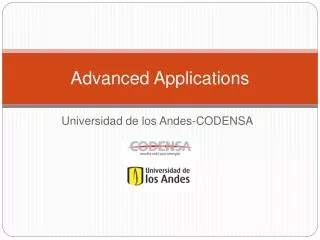
Advanced Applications
Advanced Applications. Universidad de los Andes-CODENSA. 1. Traveling Salesperson Problem. This classical optimization problem cannot be solved using traditional techniques. The goal is to find the shortest route for a salesperson to take in visiting N cities.
649 views • 47 slides

Role of Enhanced Voice Applications for SMBs
Role of Enhanced Voice Applications for SMBs. New Features Today and Tomorrow. Primal Solutions.
206 views • 5 slides
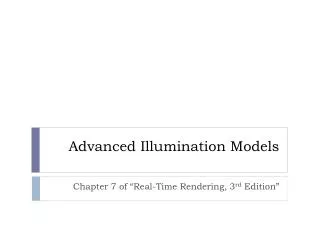
Advanced Illumination Models
Advanced Illumination Models. Chapter 7 of “Real-Time Rendering, 3 rd Edition”. Fresnel Reflectance. Fresnel Reflectance. the surface of an object can be thought of as being an interface between air and the object material
502 views • 31 slides

Advanced Composites for Fire Applications
Advanced Composites for Fire Applications. Performance By Design International. October 17, 2006 Chris Duer Engineer II Northrop Grumman Corporation. History. E34 developed testing matrix to quantify material suppliers claims of “fire proof” composites
332 views • 15 slides

Performance-Enhanced MySQL for Data Leverage
Performance-Enhanced MySQL for Data Leverage. Shivinder Singh Erick Franco. Get to Know Verizon Wireless. 74,000. Employees Nationwide at end of 1Q 2013. 98.9 Million. Retail Customers at end of 1Q 2013. Nation’s largest 4G LTE network. $75.9 Billion. Annual Revenue (2012).
266 views • 18 slides
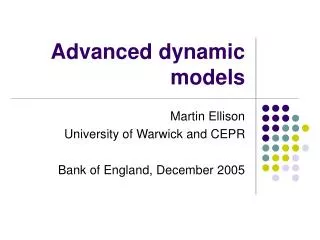
Advanced dynamic models
Advanced dynamic models. Martin Ellison University of Warwick and CEPR Bank of England, December 2005. Impulses. Propagation. Fluctuations. More complex models. Frisch-Slutsky paradigm. Impulses. Can add extra shocks to the model. Shocks may be correlated. Propagation.
273 views • 14 slides

Unit-4 Enhanced Data Models for Advanced Applications
Unit-4 Enhanced Data Models for Advanced Applications. Dr. K. Raghava Rao Professor of CSE Dept. of MCA,KL University krraocse@gmail.com http://advdbms.blog.com. Active Database Concepts and Triggers. Generalized Model for Active Databases and Oracle Triggers
884 views • 61 slides
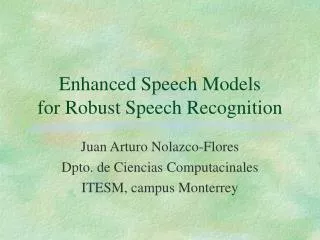
Enhanced Speech Models for Robust Speech Recognition
Enhanced Speech Models for Robust Speech Recognition. Juan Arturo Nolazco-Flores Dpto. de Ciencias Computacinales ITESM, campus Monterrey. Talk Overview. Introduction Enhanced-Speech Models Coments and Conclusions. Questions?. Introduction. Problem:
640 views • 47 slides

Ontology-enhanced retrieval (and Ontology-enhanced applications)
Ontology-enhanced retrieval (and Ontology-enhanced applications). Deborah L. McGuinness Associate Director and Senior Research Scientist Knowledge Systems Laboratory Stanford University Stanford, CA 94305 650-723-9770 dlm@ksl.stanford.edu
347 views • 19 slides
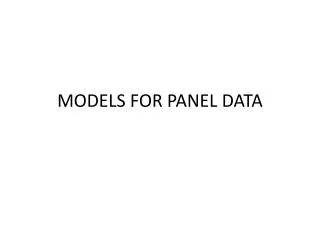
MODELS FOR PANEL DATA
MODELS FOR PANEL DATA. PANEL DATA REGRESSION. Double subscript on variables (observations) i … households, individuals, firms, countries t … period (time-series dimension) … scalar … vector K × 1 … vector of i , t th observation on K explanatory var. ONE-WAY ERROR COMPONENT MODEL.
506 views • 17 slides

Harnessing Multiple Applications for Technology Enhanced Feedback
Harnessing Multiple Applications for Technology Enhanced Feedback. Dr George Dafoulas Business Information Systems Department School of Engineering & Information Sciences Middlesex University. Agenda. Focus on feedback (4 application cases) Structure Aim & Strategy Design & Delivery
287 views • 19 slides

Advanced Optical Technologies for Data Intensive Applications
Advanced Optical Technologies for Data Intensive Applications. Kim Roberts iGrid 2005. How do I optically switch my Lightpaths?. Need to have each wavelength arriving at a node be able to leave via any of four other optical lines, or drop locally. Must be low cost. Local Add Drop.
268 views • 14 slides

Advanced Transaction Models
Advanced Transaction Models. CSE593 - Transaction Processing Philip A. Bernstein. Outline. 1. Introduction 2. Multi-transaction Requests 3. Nested Transactions 4. A Quick Research Survey. 1. Introduction.
652 views • 25 slides
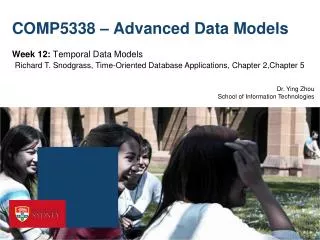
COMP5338 – Advanced Data Models
COMP5338 – Advanced Data Models. Week 12: Temporal Data Models. Richard T. Snodgrass, Time-Oriented Database Applications, Chapter 2,Chapter 5. Outline. Motivation Time and Temporal Database Concept Implementation using SQL Temporal Queries.
591 views • 35 slides

COMP5338 – Advanced Data Models
COMP5338 – Advanced Data Models. Week 11: Spatial Data Model, Query and Index. ( S. Shekhar / S.Chawla (2002): chapter 1-3; Garcia-Molina/Ullman/ Widom (2009): chapter 14). Outline. Spatial Data Model Spatial Query Concepts Spatial Index Motivation Hash Structure Tree Structure
733 views • 50 slides
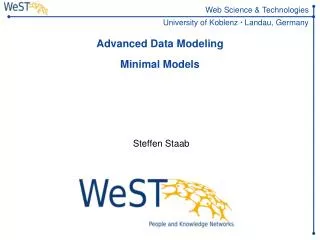
Advanced Data Modeling Minimal Models
Advanced Data Modeling Minimal Models. Steffen Staab. TexPoint fonts used in EMF. Read the TexPoint manual before you delete this box.: A A A A A. Overview. Logic as query language. Grounding. Minimal Herbrand models. Completion. Logic as query language. Given:
461 views • 36 slides

Advanced Data Types and New Applications
Advanced Data Types and New Applications. These slides are a modified version of the slides of the book “Database System Concepts” (Chapter 24), 5th Ed ., McGraw-Hill , by Silberschatz, Korth and Sudarshan. Original slides are available at www.db-book.com. Temporal Databases.
531 views • 52 slides

Role of Enhanced Voice Applications for SMBs
Role of Enhanced Voice Applications for SMBs. New Features Today and Tomorrow. Primal Solutions.
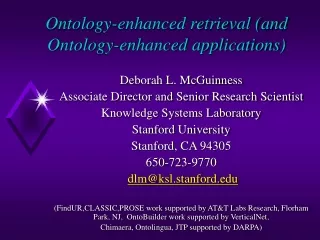
Ontology-enhanced retrieval (and Ontology-enhanced applications)
Ontology-enhanced retrieval (and Ontology-enhanced applications). Deborah L. McGuinness Associate Director and Senior Research Scientist Knowledge Systems Laboratory Stanford University Stanford, CA 94305 650-723-9770 dlm@ksl.stanford.edu
203 views • 19 slides























